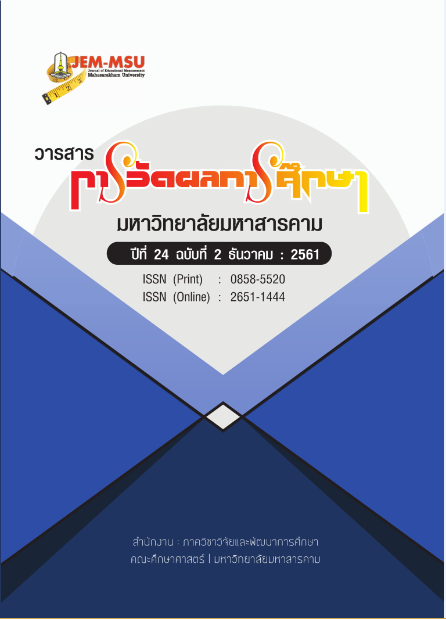The Development Guidelines for Primary School Teachers on Organizing Student-Centered Learning
Main Article Content
Abstract
The objectives of this research were 1) to study the current conditions and the desirable conditions of the development of primary school teachers on organizing student-centered learning; 2) to develop guidelines of primary school teacher development on organizing student-centered learning. The research was divided into 2 phases. Phase 1 dealt with the study of the current conditions and the desirable conditions of primary school teacher development on organizing student-centered learning. Phase 2 dealt with the development guidelines for primary school teachers on organizing student-centered learning. The population in Phase 1 consisted of 1,763 teachers from 193 schools under Yasothon Educational Service Area 1 Office. The sample comprised 313 teachers from schools under Yasothon Primary Education Service Area Office 1 in the academic year 2016. In Phase 2, the sample comprised 2 schools with the best practice and 5 experts to assess the guidelines. The instruments for data collection comprised a questionnaire, an Interview form and an evaluation form. The statistics employed in the data analysis comprised percentage, the mean, standard deviation, and the priority need index technique (PNIModified) was used in the need sorting analysis.
The results of the research were as follows:
- Regarding the current conditions and the desirable conditions of the development of primary school teachers on organizing student-centered learning, it was found that the current conditions of the development of primary school teachers on organizing student-centered learning, as a whole, were at a high level. Ranked in descending order, the aspects are: using and development of media / technology innovation in organizing learning; design of organizing learning; learning measurement and evaluation; organizing various learning processes; and creating and developing the curriculum, respectively. Regarding the desirable conditions of the development of primary school teachers on organizing student-centered learning, as a whole, they were at a high level. Ranked in descending order, the aspects are: organizing various learning processes (PNIModified = 0.21); creating and developing the curriculum (PNIModified = 0.17); design of organizing learning; (PNIModified = 0.13); using and development of media / technology innovation in organizing learning (PNIModified = 0.11); and learning measurement and evaluation (PNIModified = 0.09), respectively.
- The guidelines of primary school teacher development on organizing student-centered learning were operated on 5 aspects: creating and developing the curriculum; design of organizing learning; organizing various learning processes; using and development of media / technology innovation in organizing learning; and learning measurement and evaluation. The result of the evaluation on the guidelines of primary school teacher development on organizing student-centered learning revealed that the suitability was at a high level.
Article Details
The content and information contained in the published article in the Journal of Educational Measurement Mahasarakham University represent the opinions and responsibilities of the authors directly. The editorial board of the journal is not necessarily in agreement with or responsible for any of the content.
The articles, data, content, images, etc. that have been published in the Journal of Educational Measurement Mahasarakham University are copyrighted by the journal. If any individual or organization wishes to reproduce or perform any actions involving the entirety or any part of the content, they must obtain written permission from the Journal of Educational Measurement Mahasarakham University.
References
กระทรวงศึกษาธิการ. (2551). หลักสูตรแกนกลางการศึกษาขั้นพื้นฐาน พุทธศักราช 2551. กรุงเทพฯ :
โรงพิมพ์สหกรณ์การเกษตรแห่งประเทศไทย.
จิรพล ถาวงษ์กลาง. (2550). การพัฒนาครูด้านการจัดการเรียนรู้ที่เน้นผู้เรียนเป็นสำคัญ : กรณีศึกษา โรงเรียนโนนสะอาดพิทยา สังกัดสำนักงานเขตพื้นที่การศึกษาขอนแก่น เขต 5. วิทยานิพนธ์
ครุศาสตรมหาบัณฑิต คณะครุศาสตร์ มหาวิทยาลัยราชภัฏเลย.
ชนกพร จุฑาสงฆ์. (2559). การพัฒนาโปรแกรมการเสริมสร้างสมรรถนะการจัดการเรียนรู้ของครูสังกัด
สำนักงานส่งเสริมการศึกษานอกระบบและการศึกษาตามอัธยาศัย. วิทยานิพนธ์การศึกษา
มหาบัณฑิต คณะศึกษาศาสตร์ มหาวิทยาลัยมหาสารคาม.
ถวิล มาตรเลี่ยม. (2542). การปฏิรูปการศึกษาโรงเรียนเป็นฐานการบริหารจัดการ. กรุงเทพฯ : เสมาธรรม.
ทิศนา แขมมณี. (2542). การจัดการเรียนการสอนโดยยึดผู้เรียนเป็นศูนย์กลาง: โมเดลซิปปา (CIPPA
MODEL). วารสารวิชาการ. 2(5) : 29-36.
บุญชม ศรีสะอาด. (2553). วิจัยเบื้องต้น. พิมพ์ครั้งที่ 5. กรุงเทพฯ : สุวีริยาสาส์น.
ปรียาพร วงศ์อนุตรโรจน์. (2546). การนิเทศการสอน. กรุงเทพฯ : ศูนย์สื่อส่งเสริม.
วีระเดช เชื้อนาม. (2546). เขย่า Balanced Scorecard แล้วลงมือทำทีละขั้นตอนตลอดแนว. กรุงเทพฯ :
เฟื้องฟ้าพริ้นติ้งจำกัด.
วัฒนาพร ระงับทุกข์. (2542). แผนการสอนที่เน้นผู้เรียนเป็นศูนย์กลาง. พิมพ์ครั้งที่ 2. กรุงเทพฯ :
แอลพีเพรส.
วันเพ็ญ จันทร์เจริญ. (2542). การเรียนการสอนปัจจุบัน. สกลนคร : ฝ่ายโครงการเอกสารและตำราสถาบัน
ราชภัฏสกลนคร.
สํานักงานคณะกรรมการการศึกษาขั้นพื้นฐาน. (2547). แนวทางการพัฒนาคุณภาพการเรียนการสอนที่เน้น
ผู้เรียนเป็นสําคัญ. กรุงเทพฯ : สํานักงานคณะกรรมการการศึกษาขั้นพื้นฐาน.
สำนักงานคณะกรรมการการประถมศึกษาแห่งชาติ. (2544). เอกสารประกอบการศึกษาด้วยตนเอง หลักสูตร
ผู้ช่วยผู้บริหารและผู้บริหารสถานศึกษา. กรุงเทพฯ : โรงพิมพ์องค์การรับส่งสินค้าและพัสดุภัณฑ์
(ร.ส.พ.).
สำนักนวัตกรรมการเรียนการสอน. (2547). การพัฒนาการเรียนการสอนที่เน้นผู้เรียนเป็นสำคัญ. กรุงเทพฯ :
คลังนานาวิทยา.
อติกานต์ โชติสวัสดิ์. (2560). โปรแกรมการจัดการความรู้ของครูด้านการจัดการเรียนรู้สำหรับสถานศึกษา
สังกัดสำนักงานเขตพื้นที่การศึกษามัธยมศึกษา เขต 24. วิทยานิพนธ์การศึกษามหาบัณฑิต
คณะศึกษาศาสตร์ มหาวิทยาลัยมหาสารคาม.
อนันต์ ศรีอำไพ. (2549). เอกสารประกอบการสอนวิชา 0501702 การบริหารทรัพยากรบุคคลทาง
การศึกษา. มหาสารคาม : มหาวิทยาลัยมหาสารคาม.
อนุศาสตร์ สอนศิลพงศ์ . (2546). การพัฒนาครูประถมศึกษาตามพระราชบัญญัติการศึกษาแห่งชาติ
พ.ศ. 2542 อำเภอหนองเรือ จังหวัดขอนแก่น. รายงานการศึกษาอิสระศิลปศาสตรมหาบัณฑิต มหาวิทยาลัยขอนแก่น.


